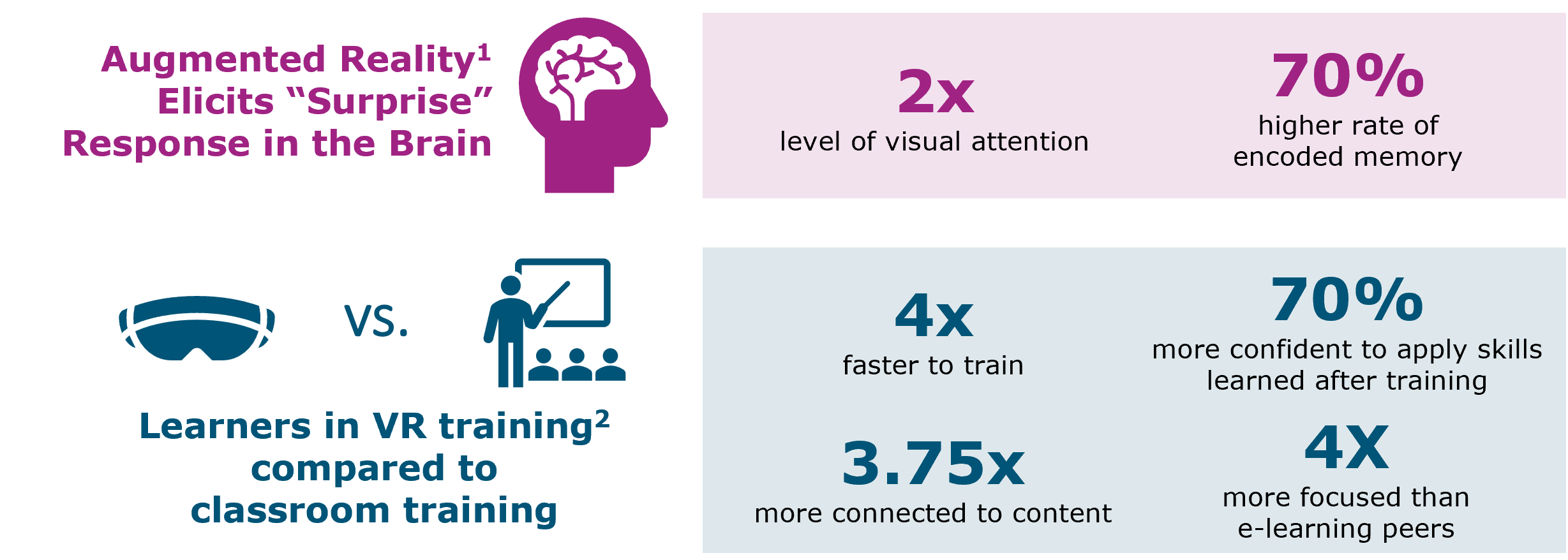The Future of Learning: The Compelling Case for Embracing Extended Reality (XR) in Education

The Future of Learning: The Compelling Case for Embracing Extended Reality (XR) in Education
Immersive Learning Impacts Student Success
A plethora of research has demonstrated immersive learning experiences, utilizing extended reality and related technologies, positively impact student success in measurable ways. Here are a few examples.

A study by Neuro-Insight found that augmented reality elicits a surprise response in the brain that results in double the level of visual attention and a 70% higher rate of encoded memory.
Another study by PwC revealed learners in VR training as compared to classroom training are four times faster to train, 70% more confident to apply skills learned after training, 3.75 times more connected to course content, and four times more focused than their e-learning peers.

A recent survey of instructors and students using AR/VR education showed positive reactions: Instructors said, "This is going to change students’ lives" and "AR VR has added a fun, exciting aspect to teaching and learning that increases student retention of information. I love it!” Students using XR said, “Using the AR/VR app improved my learning and retention of important topics" and “If I had this when taking anatomy years ago, I would have gotten an A.”
Growing Consumer Interest and Market
The XR market and consumer interest in immersive learning activities are projected to grow exponentially in the next 3 to 10 years. Millions of consumers are already using or are interested in using XR for education.

A timeline of key market projections illustrates growth in XR for education. By 2024, $4.1 billion is projected to be invested in AR/VR for training use worldwide; by 2025, global ed-tech expenditures for AR/VR are expected to be $12.6 billion; by 2028, the AR/VR market is to reach $252.16 billion; and by 2035 the AR/VR market is projected to reach $1.2 trillion.

Research on metaverse users is equally compelling. As of 2022, there are 400 million monthly active users of the metaverse worldwide, 40% of worldwide users joining the metaverse in 2021 did so for education purposes, and 28% of U.S. adults would likely join or consider joining for education opportunities.

Data on consumer interest in immersive activities, including for educational purposes, is growing. U.S. consumers expect to spend nearly 4 hours per day in the metaverse by 2027. Of the consumers, 46% are interested in attending an immersive, live learning course. Additionally, another study found that 66% of people think XR will have the most meaningful impact when applied to learning.
Future Career Skill
As the number of organizations implementing XR technologies rapidly grows across all industry sectors, there is increased labor market demand for individuals with XR skills and the emergence of XR-specific job classifications (e.g., XR Developer, XR Engineer) as well as demand for XR skills within existing job classifications (e.g., marketing manager, game producer, learning experience designer, technical artist, etc.)

Research shows 58% of U.S. companies are already using XR and 86% of companies using XR say continued investment is important. The same research shows 1 in 4 companies are using AR and VR as part of everyday business operations. Additionally, worldwide 59% of companies are expected to adopt XR technologies by 2027 and 1 in 3 will have products or services in the metaverse by 2026.
The full infographic is available in Digital Products menu, in the XR Resources directory.





